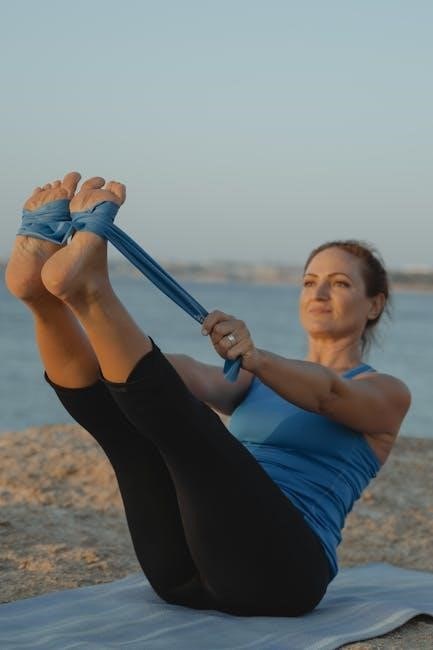Rotator cuff strengthening is essential for preventing injuries and enhancing shoulder stability. Resistance bands offer a portable, cost-effective way to improve shoulder strength and flexibility.

1.1 Importance of Rotator Cuff Strengthening
Strengthening the rotator cuff is crucial for maintaining shoulder health and preventing injuries. The rotator cuff, composed of four muscles, provides stability and mobility to the shoulder joint. Weakness or imbalances in these muscles can lead to chronic pain, limited range of motion, and increased risk of injury. Regular strengthening exercises, such as those using resistance bands, help improve shoulder stability, enhance athletic performance, and reduce the likelihood of degenerative conditions like tendinitis or tears. Additionally, strong rotator cuff muscles support proper posture and reduce strain during daily activities. By incorporating targeted exercises, individuals can promote long-term shoulder health and maintain an active lifestyle. Resistance bands are particularly effective as they provide consistent resistance throughout the movement, making them ideal for rehabilitation and strength training.
1.2 Benefits of Using Resistance Bands
Resistance bands are a versatile and effective tool for rotator cuff strengthening. They are lightweight, portable, and affordable, making them ideal for both home and gym use. Unlike heavy weights, resistance bands provide a controlled, consistent tension that minimizes stress on the joints, reducing the risk of injury. They also allow for a full range of motion, targeting specific muscles from multiple angles. This makes them particularly suitable for rehabilitation and progressive strength training. Additionally, resistance bands are easily adjustable, enabling users to customize the intensity of their workouts. Their versatility ensures that individuals at all fitness levels can benefit, whether recovering from an injury or enhancing athletic performance. This accessibility and adaptability make resistance bands a popular choice for rotator cuff exercises.

Key Concepts
Understanding the anatomy and function of the rotator cuff is crucial for effective strengthening. Resistance bands play a key role in rehabilitation and muscle stabilization, ensuring safe and progressive workouts.
2.1 Anatomy of the Rotator Cuff
The rotator cuff consists of four muscles: supraspinatus, infraspinatus, teres minor, and subscapularis. These muscles surround the shoulder joint, providing stability and enabling smooth movement. The supraspinatus supports abduction, while the infraspinatus and teres minor assist in external rotation. The subscapularis facilitates internal rotation and stabilizes the joint. Together, they form a cuff that protects the shoulder and allows for a wide range of motion. Understanding this anatomy is vital for targeting specific muscles during exercises with resistance bands, ensuring effective strengthening and rehabilitation.
2.2 Role of Resistance Bands in Rehabilitation
Resistance bands play a crucial role in rotator cuff rehabilitation by providing gentle, controlled resistance to strengthen muscles without putting excessive strain on the joint. They are versatile, allowing for a variety of exercises that target specific muscle groups. This makes them ideal for early-stage rehabilitation when traditional weights may be too heavy. Resistance bands also enable patients to perform exercises in multiple planes of motion, improving functional strength and joint stability.
Additionally, resistance bands are portable and cost-effective, making them accessible for home-based rehabilitation programs. They allow for gradual progression by increasing resistance levels as strength improves. This adaptability ensures a safe and effective recovery process for individuals with rotator cuff injuries.
2.3 Safety Tips for Effective Workouts
To ensure safe and effective workouts, start with light resistance and gradually increase as strength improves. Proper form is essential to avoid injury, so focus on slow, controlled movements. Warm up before exercises to prepare muscles and joints, and cool down afterward to prevent stiffness. Avoid overstretching or bouncing, as this can cause muscle strain. Use a high-quality resistance band that provides consistent tension and secure it to a stable object to prevent snapping. If experiencing pain, stop the exercise immediately and consult a healthcare professional. Consistency is key, but rest days are necessary to allow muscles to recover and rebuild.

Essential Exercises
Key exercises include shoulder external and internal rotations, abduction, scaption, and reverse fly. These movements target the rotator cuff, improving strength, stability, and mobility effectively.
3.1 Shoulder External Rotation
Shoulder external rotation targets the infraspinatus and teres minor muscles. To perform, tie the resistance band to a stable object at shoulder height. Hold the band with both hands, palms facing your thighs. Keeping elbows close to your body, slowly rotate your shoulders outward, pulling the band apart. Maintain control as you return to the starting position. Repeat for 12-15 repetitions, aiming for 2-3 sets. This exercise enhances rotational strength and improves joint stability, crucial for activities like throwing and overhead movements. It’s also beneficial for rehabilitation, promoting proper scapular mechanics and reducing injury risk.
3.2 Shoulder Internal Rotation
Shoulder internal rotation strengthens the subscapularis muscle, enhancing shoulder stability and preventing injuries. Anchor the resistance band at shoulder height behind you. Hold the band with both hands, palms facing backward. Keeping elbows close to your body, pull the band toward your abdomen, rotating your shoulders inward. Control the movement as you return to the starting position. Perform 12-15 repetitions for 2-3 sets. This exercise improves internal rotational strength, crucial for activities like pulling and swimming. It also enhances overall shoulder stability, reducing the risk of rotator cuff injuries and improving joint mechanics. Consistency with this exercise supports long-term shoulder health and functional movement.
3.3 Shoulder Abduction
Shoulder abduction targets the deltoid and supraspinatus muscles, improving shoulder mobility and strength. Anchor the resistance band at hip height. Hold the ends with both hands, arms at your sides, palms facing your thighs. Keeping your arms straight, lift the band out to the sides until your arms are at shoulder height. Avoid shrugging your shoulders. Slowly return to the starting position. Perform 12-15 repetitions for 2-3 sets. This exercise enhances overhead reach and stability, benefiting activities like lifting and throwing. It also strengthens the rotator cuff, reducing injury risk and improving overall shoulder function. Consistent practice promotes better posture and movement efficiency.
3.4 Scaption (Diagonal Abduction)
Scaption, or diagonal abduction, combines elements of shoulder abduction and external rotation, targeting the supraspinatus and deltoid muscles. Anchor the resistance band at hip level. Hold the ends with your hands, arms extended, and palms facing your thighs. Lift the band diagonally upward, keeping your arms straight, until they form a 45-degree angle with your body. Avoid arching your back. Slowly lower to the starting position. Perform 12-15 repetitions for 2-3 sets; This exercise improves overhead mobility and strengthens the rotator cuff, enhancing stability for activities like swimming or overhead throws. It also reduces shoulder impingement risk, promoting healthier joint movement and overall shoulder function. Consistent practice supports better posture and reduces injury risk during daily activities and sports.
3.5 Reverse Fly
The reverse fly targets the posterior deltoids and rhomboids, enhancing scapular stability and overall shoulder health. Hold the resistance band in both hands, arms extended, and stand facing the anchor point. Bend slightly at the knees and hips. Pull the band outward, keeping your arms straight, until your hands are at shoulder height. Avoid rounding your shoulders. Return slowly to the starting position. Aim for 12-15 repetitions across 2-3 sets. This exercise strengthens the muscles that stabilize the shoulder blade, reducing the risk of shoulder injuries. It also improves posture and enhances athletic performance, particularly in sports requiring lateral movements, like tennis or swimming. Regular practice helps maintain balanced shoulder development and prevents muscle imbalances that could lead to long-term discomfort or injury. Consistency is key for optimal results and sustained shoulder health.
Progression and Variation
Gradually increase resistance by using thicker bands or altering anchor points. Incorporate variations like angle changes or combined movements to enhance effectiveness and prevent plateaus.
4.1 Adjusting Resistance Levels
Adjusting resistance levels is crucial for progressive overload in rotator cuff exercises. Start with lighter bands to focus on form and control, then gradually increase resistance as strength improves. Thicker bands or layering multiple bands can enhance challenge. For example, if performing shoulder external rotations, begin with a light resistance band and progress to heavier ones as the movement becomes easier. This ensures continuous muscle engagement and prevents stagnation. Always assess the band’s tension by performing a few reps; if it feels too easy, it’s time to step up. Proper progression ensures optimal strength gains and injury rehabilitation.
4.2 Incorporating Variation Techniques
Incorporating variation techniques into your rotator cuff exercises with resistance bands enhances engagement and prevents plateaus. Try altering the angle of your movements, such as performing exercises overhead or at shoulder height. Experiment with different body positions, like standing, kneeling, or lying down, to target muscles from various perspectives. Additionally, vary the plane of motion—switch between frontal, sagittal, and transverse planes to ensure comprehensive strengthening. Modify your grip width or use neutral vs. pronated grips to emphasize different muscle fibers. Finally, combine band exercises with bodyweight or free-weight movements for added variety. These techniques ensure a well-rounded workout and maximize shoulder stability and strength.

Creating a PDF Guide
Creating a rotator cuff strengthening guide with resistance bands ensures comprehensive, portable workouts. Include clear instructions, visuals, and routines for optimal results.
5.1 Steps to Develop a Comprehensive Guide
Creating a detailed PDF guide for rotator cuff strengthening with resistance bands involves several key steps. First, define the target audience and their fitness goals. Next, outline the exercises, ensuring clarity and progression. Include high-quality images or diagrams to illustrate proper form. Provide safety tips and guidelines for choosing the right resistance level. Add a sample routine with sets, reps, and frequency. Finally, review and format the guide for readability, ensuring it is both informative and easy to follow. This structured approach guarantees a valuable resource for anyone aiming to strengthen their shoulders effectively.
5.2 Sample Exercise Routine
A well-structured routine might include 3–4 exercises, 3 sets of 12–15 reps each, performed 3–4 times weekly. Begin with shoulder external rotations, securing the band to a stable object. Perform 3 sets, then transition to internal rotations. Next, focus on shoulder abduction and scaption for balanced development. Conclude with reverse fly to target the rear deltoids. Rest for 30–60 seconds between sets and adjust resistance as strength improves. This routine promotes comprehensive shoulder stability and strength, essential for injury prevention and rehabilitation. Consistency and proper form are key to achieving desired results.



